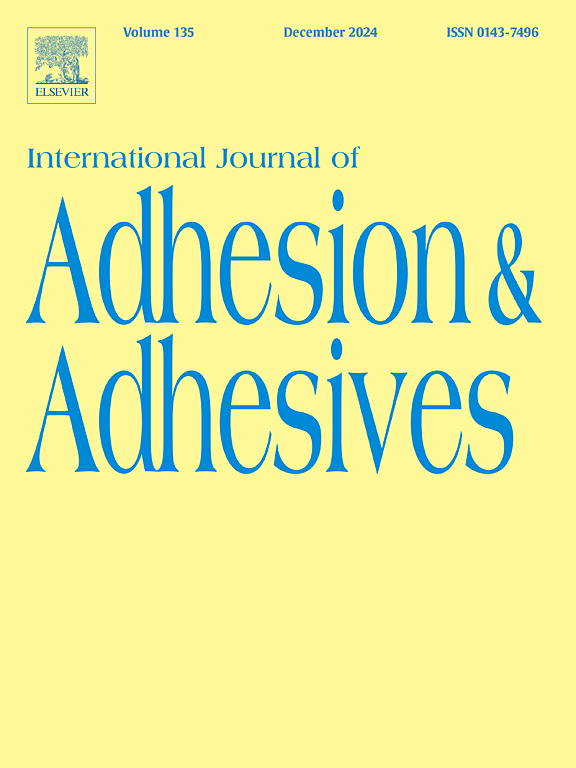二醇分子结构不同对生物基木材胶粘剂性能的影响
IF 3.2
3区 材料科学
Q2 ENGINEERING, CHEMICAL
International Journal of Adhesion and Adhesives
Pub Date : 2025-01-02
DOI:10.1016/j.ijadhadh.2025.103936
引用次数: 0
摘要
本研究旨在探讨脂肪族和芳香族不同的二醇结构对可再生木材胶粘剂的影响。因此,以1,3-丙二醇(PRD)、1,5-戊二醇(PED)和对苯二酚(HQ)作为交联剂与非食用油基多元醇(蓖麻油(CO))进行交联。基于hq的木材胶粘剂样品预计会表现出更高的机械强度,因为它的芳香结构可以赋予刚性,并可能导致机械性能的提高。将不同重量百分比的二元醇与生物多元醇和异氰酸酯混合制备聚氨酯(PU)基木材胶粘剂,探讨增加二元醇浓度对胶粘剂性能的影响。所有样品在四种不同温度(室温,50°C, 75°C和100°C)下固化,以研究热稳定性和机械强度。出乎意料的是,在所有制备的胶粘剂样品中,PRD样品的机械强度最高(5.1 MPa)。对所有制备的样品进行凝胶和膨胀测试以评估溶解度,然后进行FT-IR分析以评估这些测试后的结构变化。合成的粘接材料无明显变化,表明交联良好。我们的研究结果强调了生物基材料在高级木材粘合剂应用中的重要性,这为设计具有最佳特性的可持续PU粘合剂提供了有价值的见解。本文章由计算机程序翻译,如有差异,请以英文原文为准。

Effect of distinct molecular structure of diols on the properties of bio-based wood adhesive
This study aimed to investigate the effect of different diol structures, both aliphatic and aromatic, on wood adhesives derived from renewable sources. Therefore, 1,3-propanediol (PRD), 1,5-pentanediol (PED), and hydroquinone (HQ) were used as crosslinkers with a non-edible oil-based polyol (castor oil (CO)). The HQ-based wood adhesive sample was anticipated to demonstrate higher mechanical strength due to its aromatic structure, which can impart rigidity and potentially lead to increased mechanical properties. Different weight percentages of diols relative to the bio-polyol were incorporated with the bio-polyol and isocyanate to prepare polyurethane (PU)-based wood adhesives, aiming to explore the effect of increasing diol concentrations on adhesive properties. All samples were cured at four different temperatures (room temperature, 50 °C, 75 °C, and 100 °C) to investigate thermal stability and mechanical strength. Unexpectedly, among all prepared adhesive samples, the PRD sample exhibited the highest mechanical strength (5.1 MPa). Gel and swell tests were conducted on all prepared samples to evaluate solubility, followed by FT-IR analysis to assess structural changes after these tests. No major changes were observed in the synthesized adhesive materials, indicating good crosslinking. The importance of bio-based materials in advanced wood adhesive applications is highlighted by our findings, which provide valuable insights into the design of sustainable PU adhesives with optimal characteristics.
求助全文
通过发布文献求助,成功后即可免费获取论文全文。
去求助
来源期刊

International Journal of Adhesion and Adhesives
工程技术-材料科学:综合
CiteScore
6.90
自引率
8.80%
发文量
200
审稿时长
8.3 months
期刊介绍:
The International Journal of Adhesion and Adhesives draws together the many aspects of the science and technology of adhesive materials, from fundamental research and development work to industrial applications. Subject areas covered include: interfacial interactions, surface chemistry, methods of testing, accumulation of test data on physical and mechanical properties, environmental effects, new adhesive materials, sealants, design of bonded joints, and manufacturing technology.
 求助内容:
求助内容: 应助结果提醒方式:
应助结果提醒方式:


